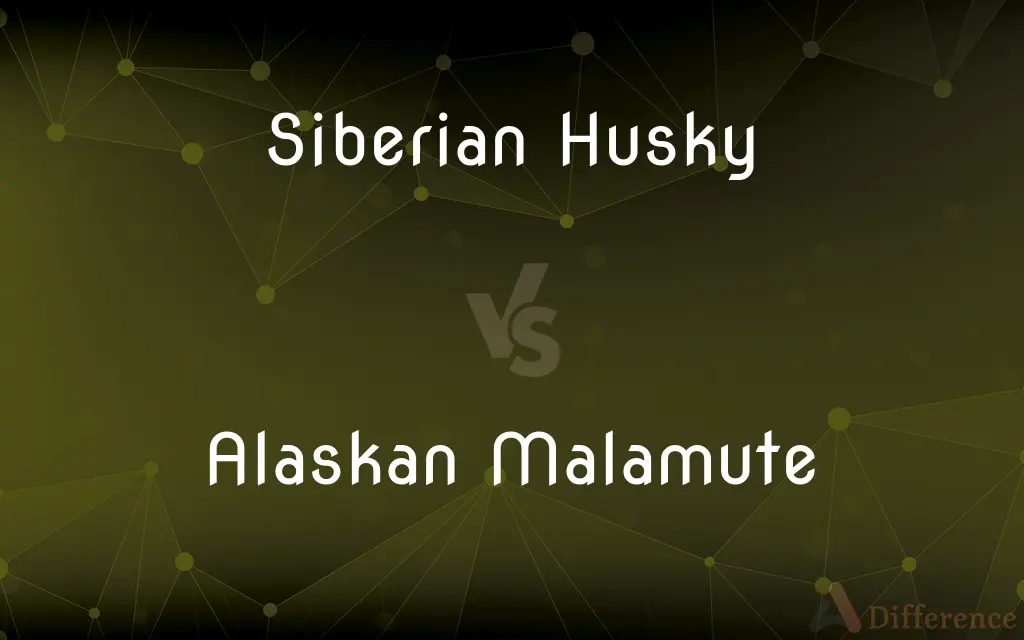Siberian Husky vs. Alaskan Malamute — What's the Difference?
By Tayyaba Rehman — Published on November 22, 2023
The Siberian Husky is a medium-sized, nimble dog breed with a lighter build, while the Alaskan Malamute is a larger, robust breed primarily used for heavy hauling.

Difference Between Siberian Husky and Alaskan Malamute
Table of Contents
ADVERTISEMENT
Key Differences
The Siberian Husky and Alaskan Malamute are both stunning dog breeds known for their wolf-like appearance and connections to colder climates. However, they have distinct characteristics and histories. Originating in Northeast Asia, the Siberian Husky was bred by the Chukchi people for sled pulling and companionship. These dogs are known for their agility and endurance in harsh climates. The Alaskan Malamute, on the other hand, hails from the Arctic region, bred by the Malamute Inuit tribe for strength and stamina to haul heavy freight.
Both breeds have thick double coats, but the Siberian Husky's coat comes in a wider range of colors. Their eyes are captivating, and while both breeds can have blue eyes, the Siberian Husky is famed for having heterochromia, where each eye can be a different color. The Alaskan Malamute typically possesses a more solid build and has eyes that are either brown or hazel.
In terms of size, Siberian Huskies are generally medium-sized, weighing between 35 to 60 pounds, while Alaskan Malamutes are heftier, often weighing between 75 to 100 pounds. This weight difference is a testament to their primary tasks; the Siberian Husky is built for speed and agility, whereas the Alaskan Malamute is built for power and strength.
Temperament-wise, both breeds are friendly, but Siberian Huskies are often more outgoing and mischievous. They may be slightly harder to train due to their independent nature. Alaskan Malamutes, being pack animals, have a strong leadership instinct and require an owner who can assert dominance.
Comparison Chart
Origin
Northeast Asia (Chukchi people)
Arctic region (Malamute Inuit tribe)
ADVERTISEMENT
Size
Medium (35 to 60 pounds)
Larger (75 to 100 pounds)
Coat Colors
Wide range of colors
Limited colors, usually shades of gray & white
Eye Colors
Blue, brown, green, or heterochromia
Brown or hazel
Primary Function
Sled pulling, agility
Heavy hauling, strength
Compare with Definitions
Siberian Husky
A medium-sized dog breed known for agility and sled-pulling capabilities.
The Siberian Husky dashed through the snow with incredible speed.
Alaskan Malamute
A large dog breed renowned for its strength and heavy hauling capabilities.
The Alaskan Malamute easily pulled the loaded sled across the icy terrain.
Siberian Husky
A resilient breed adapted to cold environments with a thick double coat.
The Siberian Husky's coat kept it warm even in the harshest of winters.
Alaskan Malamute
A robust and sturdy breed with a wolf-like appearance and double coat.
The thick coat of the Alaskan Malamute protected it from freezing temperatures.
Siberian Husky
A dog breed that can display heterochromia, having two different colored eyes.
Her Siberian Husky had one blue eye and one brown, making it uniquely beautiful.
Alaskan Malamute
A breed originating from the Arctic, bred by the Malamute Inuit tribe.
The Alaskan Malamute's history is deeply rooted in Arctic survival.
Siberian Husky
A dog breed originating from Northeast Asia with a distinct wolf-like appearance.
The striking eyes of the Siberian Husky often captivate onlookers.
Alaskan Malamute
A loyal and dominant breed requiring strong leadership from its owner.
Training the Alaskan Malamute required consistency and assertiveness.
Siberian Husky
An energetic, friendly, and sometimes mischievous breed.
The Siberian Husky playfully chased its tail, amusing everyone around.
Alaskan Malamute
A dog breed known for its endurance and power, often used for pulling heavy loads.
In weight-pulling competitions, the Alaskan Malamute often emerged as the champion.
Common Curiosities
Which breed is larger, the Siberian Husky or Alaskan Malamute?
The Alaskan Malamute is larger and heavier than the Siberian Husky.
Are both breeds suitable for warm climates?
Both breeds have thick coats adapted for cold climates, but with proper care, they can adapt to warmer conditions.
Which breed is better for sled racing?
The Siberian Husky, being more agile and faster, is often preferred for sled racing.
Are Alaskan Malamutes good family pets?
Yes, Alaskan Malamutes are loyal and protective, making them good family pets with proper training.
Are Siberian Huskies and Alaskan Malamutes related breeds?
While they share some similarities, they have distinct origins and were bred for different purposes.
Is it hard to train a Siberian Husky?
Siberian Huskies can be independent and sometimes stubborn, so consistent training is essential.
Which breed has a wider variety of coat colors?
The Siberian Husky has a wider range of coat colors compared to the Alaskan Malamute.
Which breed is more vocal and expressive?
Siberian Huskies are known to be more vocal, often "talking" or howling.
Do both breeds require a lot of exercise?
Yes, both breeds are active and require regular exercise and mental stimulation.
Are either of these breeds hypoallergenic?
No, neither the Siberian Husky nor the Alaskan Malamute is hypoallergenic.
Which breed has a stronger prey drive?
Both breeds have a prey drive, but Siberian Huskies tend to have a stronger instinct to chase.
How often should you groom these breeds?
Regular grooming is essential for both breeds, especially during their shedding seasons.
Are Alaskan Malamutes good with other dogs?
With proper socialization, they can be, but they have a dominant nature and may try to assert themselves.
Do Siberian Huskies make good guard dogs?
Siberian Huskies are friendly and sociable, making them less suitable as guard dogs.
Share Your Discovery

Previous Comparison
Civil War vs. Revolution
Next Comparison
Nervous Breakdown vs. Panic AttackAuthor Spotlight
Written by
Tayyaba RehmanTayyaba Rehman is a distinguished writer, currently serving as a primary contributor to askdifference.com. As a researcher in semantics and etymology, Tayyaba's passion for the complexity of languages and their distinctions has found a perfect home on the platform. Tayyaba delves into the intricacies of language, distinguishing between commonly confused words and phrases, thereby providing clarity for readers worldwide.
















































